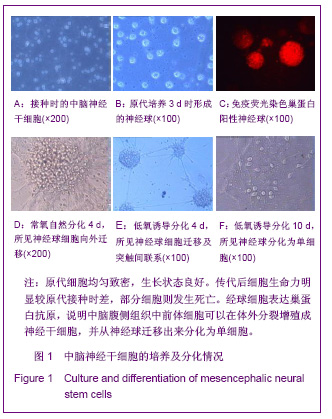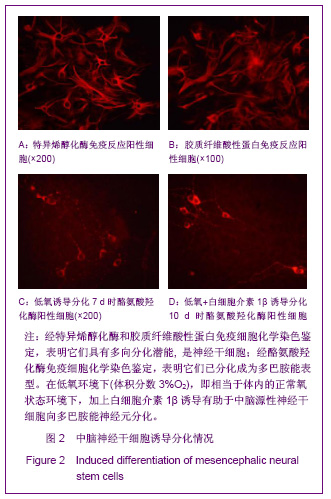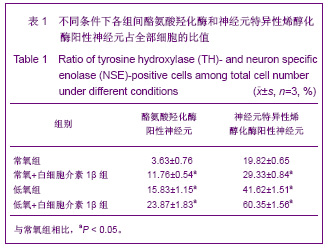中国组织工程研究 ›› 2013, Vol. 17 ›› Issue (10): 1809-1813.doi: 10.3969/j.issn.2095-4344.2013.10.016
• 干细胞培养与分化 stem cell culture and differentiation • 上一篇 下一篇
低氧环境下白细胞介素1β诱导中脑源性神经干细胞的分化
丁继固1,丁文杰2,李 光3
- 1 湖北科技学院人体解剖学教研室,湖北省咸宁市 437100
2 湖北科技学院口腔学教研室,湖北省咸宁市 437100
3 武汉大学中南医院重症医学科,湖北省武汉市 43007
Differentiation of mesencephalic neural stem cells induced by interleukin-1beta under hypoxic condition
Ding Ji-gu1, Ding Wen-jie2, Li Guang3
- 1 Department of Human Anatomy, Hubei University of Science and Technology, Xianning 437100, Hubei Province, China
2 Department of Stomatology, Hubei University of Science and Technology, Xianning 437100, Hubei Province, China
3 Department of Critical Care Medicine, Wuhan 430071, Hubei Province, China
摘要:
背景:在体外某些外来信号的调控和诱导下,神经干细胞可定向诱导分化成与受体部位细胞类型与构成相似的细胞群体,使其更容易掺入靶组织,并可满足移植所需的细胞数量,提高移植细胞的存活率。 目的:验证白细胞介素1β在低氧环境下体外诱导中脑源性神经干细胞的分化。 方法:分离孕12 d胎鼠中脑组织,培养神经干细胞、传代并鉴定。将鉴定后传代培养的中脑源性神经干细胞按分组接种于含体积分数10%胎牛血清的DMEM/F12培养基和含体积分数10%胎牛血清的DMEM/ F12+白细胞介素1β培养基;分别置于常氧(体积分数21%O2)和低氧(体积分数3%O2)环境下诱导分化,诱导分化9-11 d后行小鼠抗大鼠酪氨酸羟化酶免疫细胞化学染色,检测酪氨酸羟化酶及神经元特异性烯醇化酶阳性细胞率。 结果与结论:与常氧组比较,低氧组尤其是低氧+白细胞介素1β组中酪氨酸羟化酶阳性神经元的突起数目更多,且长度更为延长。孕12 d胚鼠腹侧中脑组织可以在体外培养传代、并能诱导分化成多巴胺能神经元;在低氧环境或低氧+白细胞介素1β诱导下,分化率均高于常氧组,其表型更成熟。说明在低氧或低氧和白细胞介素1β诱导下,可明显促进中脑源性干细胞分化为形态及功能成熟的多巴胺能神经元。
中图分类号:




